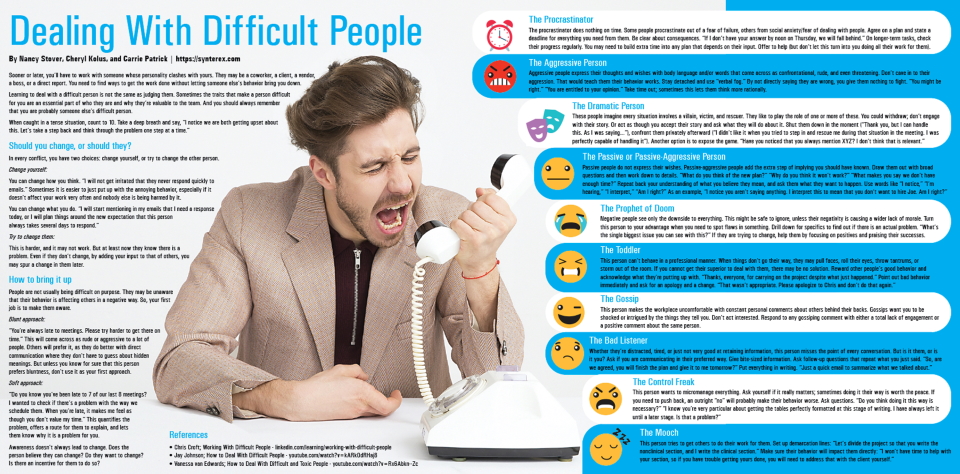Difficult people exist in any profession. Download this poster, presented by Synterex at the 2022 American Medical Writers Association (AMWA) conference, or scroll down for a text-only version.

Sooner or later, you’ll have to work with someone whose personality clashes with yours. They may be a coworker, a client, a vendor, a boss, or a direct report. You need to find ways to get the work done without letting someone else’s behavior bring you down.
Learning to deal with a difficult person is not the same as judging them. Sometimes the traits that make a person difficult for you are an essential part of who they are and why they’re valuable to the team. And you should always remember that you are probably someone else’s difficult person.
When caught in a tense situation, count to 10. Take a deep breath and say, “I notice we are both getting upset about this. Let’s take a step back and think through the problem one step at a time.”
Should you change, or should they?
In every conflict, you have two choices: change yourself, or try to change the other person.
Change yourself:
- You can change how you think. “I will not get irritated that they never respond quickly to emails.” Sometimes it is easier to just put up with the annoying behavior, especially if it doesn’t affect your work very often and nobody else is being harmed by it.
- You can change what you do. “I will start mentioning in my emails that I need a response today, or I will plan things around the new expectation that this person always takes several days to respond.”
Try to change them:
This is harder, and it may not work. But at least now they know there is a problem. Even if they don’t change, by adding your input to that of others, you may spur a change in them later.
How to bring it up
People are not usually being difficult on purpose. They may be unaware that their behavior is affecting others in a negative way. So, your first job is to make them aware.
Blunt approach:
“You’re always late to meetings. Please try harder to get there on time.” This will come across as rude or aggressive to a lot of people. Others will prefer it, as they do better with direct communication where they don’t have to guess about hidden meanings. But unless you know for sure that this person prefers bluntness, don’t use it as your first approach.
Soft approach:
“Do you know you’ve been late to 7 of our last 8 meetings? I wanted to check if there’s a problem with the way we schedule them. When you’re late, it makes me feel as though you don’t value my time.” This quantifies the problem, offers a route for them to explain, and lets them know why it is a problem for you.
Awareness doesn’t always lead to change. Does the person believe they can change? Do they want to change? Is there an incentive for them to do so?
Types of Difficult People
The Procrastinator
The procrastinator does nothing on time. Some people procrastinate out of a fear of failure, others from social anxiety/fear of dealing with people. Agree on a plan and state a deadline for everything you need from them. Be clear about consequences. “If I don’t have your answer by noon on Thursday, we will fall behind.” On longer-term tasks, check their progress regularly. You may need to build extra time into any plan that depends on their input. Offer to help (but don’t let this turn into you doing all their work for them).
The Aggressive Person
Aggressive people express their thoughts and wishes with body language and/or words that come across as confrontational, rude, and even threatening. Don’t cave in to their aggression. That would teach them their behavior works. Stay detached and use “verbal fog.” By not directly saying they are wrong, you give them nothing to fight. “You might be right.” “You are entitled to your opinion.” Take time out; sometimes this lets them think more rationally.
The Dramatic Person
These people imagine every situation involves a villain, victim, and rescuer. They like to play the role of one or more of these. You could withdraw; don’t engage with their story. Or act as though you accept their story and ask what they will do about it. Shut them down in the moment (“Thank you, but I can handle this. As I was saying…”), confront them privately afterward (“I didn’t like it when you tried to step in and rescue me during that situation in the meeting. I was perfectly capable of handling it”). Another option is to expose the game. “Have you noticed that you always mention XYZ? I don’t think that is relevant.”
The Passive or Passive-Aggressive Person
Passive people do not express their wishes. Passive-aggressive people add the extra step of implying you should have known. Draw them out with broad questions and then work down to details. “What do you think of the new plan?” “Why do you think it won’t work?” “What makes you say we don’t have enough time?” Repeat back your understanding of what you believe they mean, and ask them what they want to happen. Use words like “I notice,” “I’m hearing,” “I interpret,” “Am I right?” As an example, “I notice you aren’t saying anything. I interpret this to mean that you don’t want to hire Joe. Am I right?”
The Prophet of Doom
Negative people see only the downside to everything. This might be safe to ignore, unless their negativity is causing a wider lack of morale. Turn this person to your advantage when you need to spot flaws in something. Drill down for specifics to find out if there is an actual problem. “What’s the single biggest issue you can see with this?” If they are trying to change, help them by focusing on positives and praising their successes.
The Toddler
This person can’t behave in a professional manner. When things don’t go their way, they may pull faces, roll their eyes, throw tantrums, or storm out of the room. If you cannot get their superior to deal with them, there may be no solution. Reward other people’s good behavior and acknowledge what they’re putting up with. “Thanks, everyone, for carrying on the project despite what just happened.” Point out bad behavior immediately and ask for an apology and a change. “That wasn’t appropriate. Please apologize to Chris and don’t do that again.”
The Gossip
This person makes the workplace uncomfortable with constant personal comments about others behind their backs. Gossips want you to be shocked or intrigued by the things they tell you. Don’t act interested. Respond to any gossiping comment with either a total lack of engagement or a positive comment about the same person.
The Bad Listener
Whether they’re distracted, tired, or just not very good at retaining information, this person misses the point of every conversation. But is it them, or is it you? Ask if you are communicating in their preferred way. Give bite-sized information. Ask follow-up questions that repeat what you just said. “So, are we agreed, you will finish the plan and give it to me tomorrow?” Put everything in writing. “Just a quick email to summarize what we talked about.”
The Control Freak
This person wants to micromanage everything. Ask yourself if it really matters; sometimes doing it their way is worth the peace. If you need to push back, an outright “no” will probably make their behavior worse. Ask questions. “Do you think doing it this way is necessary?” “I know you’re very particular about getting the tables perfectly formatted at this stage of writing. I have always left it until a later stage. Is that a problem?”
The Mooch
This person tries to get others to do their work for them. Set up demarcation lines: “Let’s divide the project so that you write the nonclinical section, and I write the clinical section.” Make sure their behavior will impact them directly: “I won’t have time to help with your section, so if you have trouble getting yours done, you will need to address that with the client yourself.”
References
Chris Croft; Working With Difficult People – linkedin.com/learning/working-with-difficult-people
Jay Johnson; How to Deal With Difficult People – youtube.com/watch?v=kARkOdRHaj8
Vanessa van Edwards; How to Deal With Difficult and Toxic People – youtube.com/watch?v=Rx6Abkn–Zc
